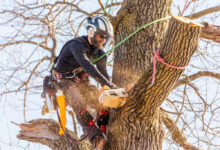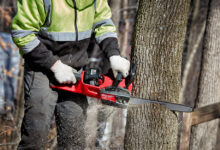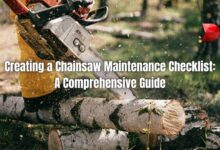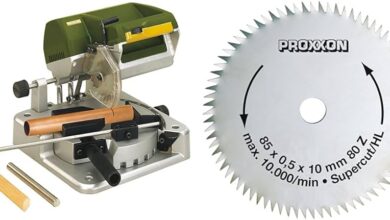Contents
Introduction:
The relentless rhythm of a chainsaw’s cutting teeth can conquer even the most formidable timber, transforming dense forests into usable lumber or clearing paths through overgrown undergrowth. However, to harness the full potential of this powerful tool, it is imperative to master the art of chainsaw tension adjustment—a delicate balance between ensuring optimal cutting performance and safeguarding the integrity of the saw itself.
This article delves into the intricacies of chainsaw tension adjustment, unraveling the nuances of this crucial maintenance procedure. From understanding the fundamentals to mastering advanced techniques, we explore the complete spectrum of tension adjustment best practices.
Understanding Chainsaw Tension
The tension of a chainsaw relates to the tightness of the saw chain, a continuous loop of interlocking teeth that forms the business end of the machine. Proper tension ensures that the chain remains securely in place on the guide bar, preventing derailment while allowing it to move freely for efficient cutting.
The Goldilocks Zone:
Finding the ideal tension for a chainsaw chain is akin to balancing on a razor’s edge. Too loose, and the chain risks jumping off the guide bar during operation, potentially causing injury or damage to the saw. Too tight, and the increased friction can strain the chain, guide bar, and sprocket, leading to premature wear and decreased cutting performance.
The Tension Gauge: Your Trusty Ally
Navigating the complexities of tension adjustment is made simpler with the help of a tension gauge, an indispensable tool in any chainsaw owner’s arsenal. This simple device, typically a small metal hook or lever, provides an accurate reading of the chain’s tension, ensuring that it falls within the recommended range specified by the saw’s manufacturer.
The Art of Chainsaw Tension Adjustment
Mastering chainsaw tension adjustment requires a combination of knowledge, precision, and a keen eye for detail. Follow these step-by-step instructions to achieve the perfect tension for optimal cutting performance:
1. Prepare Your Saw:
Before embarking on tension adjustment, ensure that your chainsaw is unplugged or the engine is turned off and cooled down. Disconnect the spark plug wire as an added safety precaution.
2. Inspect the Chain:
Thoroughly examine the saw chain for any signs of damage or excessive wear. If necessary, sharpen or replace the chain to ensure peak performance.
3. Measure the Tension:
Using a tension gauge, carefully measure the tension of the chain. The target tension range is usually specified in the saw’s user manual, typically between 1/16″ and 1/8″ of deflection.
4. Adjust the Tension:
If the tension is too loose, tighten the chain tensioner screw or knob located near the guide bar. Conversely, if the tension is too tight, loosen the screw or knob slightly.
5. Re-measure and Refine:
Use the tension gauge to re-measure the tension after making adjustments. Repeat the tensioning process until the desired tension is achieved.
6. Secure the Chain:
Once the ideal tension is reached, secure the chain by tightening the tensioner screw or knob firmly.
7. Final Check:
With the chain tensioned, manually pull the chain around the guide bar to ensure it moves freely without binding or excessive slack.
Strengths and Weaknesses of Chainsaw Tension Adjustment Tips
Strengths:
1. Improved Cutting Efficiency: Proper chain tension enhances cutting performance, allowing the saw to slice through wood with ease.
2. Reduced Chain Derailment: Correct tension minimizes the risk of the chain jumping off the guide bar, improving safety and preventing damage to the saw.
3. Extended Component Life: Optimal chain tension reduces wear and tear on the chain, guide bar, and sprocket, prolonging their lifespan.
4. Simplified Maintenance: Regular tension adjustment makes other maintenance tasks, such as chain sharpening and lubrication, more effective.
Weaknesses:
1. Requires Regular Attention: Chainsaw tension can change over time due to factors like chain wear and temperature variations, necessitating regular adjustment.
2. Potential for Over-Tightening: Excessive tension can strain the chain and other components, leading to breakage or premature wear.
3. Can Be Fiddly: The process of tension adjustment can be time-consuming and may require patience and practice to master.
Chainsaw Tension Adjustment Tips Table
| Aspect | Guideline | Description |
|—|—|—|
| Chain Deflection | 1/16″ – 1/8″ | Optimal range for most chainsaw applications |
| Tension Gauge | Use a tension gauge for accurate measurements | Ensures consistent and precise tension |
| Tool Placement | Locate the tensioner screw or knob near the guide bar | Varies depending on the saw model |
| Inspection | Check chain tension regularly, especially after prolonged use | Preemptive adjustment prevents potential problems |
| Repair vs. Replace | Replace damaged or worn chains to maintain optimal tension | Extends the life of the chainsaw |
FAQs on Chainsaw Tension Adjustment
1. How often should I adjust the tension of my chainsaw chain? – Adjust the chain tension regularly, ideally before each use or every few hours of operation.
2. What could happen if I run my chainsaw with the chain too loose? – Excessive chain looseness increases the risk of derailment, which can be dangerous and damaging to the saw.
3. What are the consequences of running my chainsaw with the chain too tight? – Over-tightening the chain can cause it to snap or prematurely wear out the chain, guide bar, and sprocket.
4. Is it okay to use a pliers to adjust the chain tension? – Using pliers may result in uneven or inaccurate tension. A tension gauge is recommended for optimal results.
5. My chainsaw chain seems to stretch easily. What could be the reason? – Excessive chain stretching can be caused by factors like poor lubrication or blunt teeth. Address these issues to improve chain tension retention.
6. What is the recommended tension for a specific chainsaw model? – Consult the user manual for the manufacturer’s specifications regarding optimal chain tension.
7. How do I know if the chain is tensioned properly by hand? – A properly tensioned chain should move freely when pulled by hand, without excessive slack or binding.
8. What are the benefits of using a torque wrench for chain tension adjustment? – A torque wrench provides precise control over the tensioning force, ensuring optimal tension without the risk of over-tightening.
9. Can I adjust the tension of the chain while the chainsaw is running? – For safety reasons, it is strongly advised against adjusting the chain tension while the chainsaw is running.
10. How does chain temperature affect its tension? – As the chain heats up during use, it may expand slightly, potentially affecting its tension. Allow the chain to cool before adjusting.
11. What is the maximum tension I can apply to a chainsaw chain? – The maximum tension varies depending on the saw model and chain type. Refer to the manufacturer’s guidelines for specific recommendations.
12. Can I use a different type of chain on my chainsaw? – Different types of chains may require different tension adjustments. Always use the chain specified by the chainsaw manufacturer.
13. What should I do if the tensioner screw or knob does not loosen? – If the tensioner component is stuck, try using a penetrating oil or seeking the assistance of a qualified mechanic.
Conclusion:
Mastering the art of chainsaw tension adjustment empowers you to unleash the full potential of this versatile tool, enhancing cutting efficiency, safety, and the lifespan of your chainsaw. By following the guidelines and tips outlined in this comprehensive guide, you can ensure that your chainsaw is always ready to tackle any cutting task with precision and confidence.
As a responsible chainsaw operator, it is imperative to prioritize regular tension adjustment as part of your routine maintenance regimen. This simple yet crucial procedure goes a long way in safeguarding both yourself and your chainsaw from potential hazards. By incorporating the knowledge and techniques presented here into your chainsaw maintenance practices, you will unlock the ultimate cutting performance that your chainsaw has to offer.
Remember, proper chainsaw tension adjustment is not merely a technical skill but a testament to your commitment to safety and efficiency. Embracing these principles empowers you to maximize the utility of your chainsaw, transforming it from a mere cutting tool into an indispensable companion for all your forestry and woodworking endeavors.









